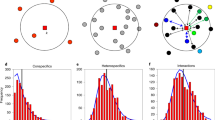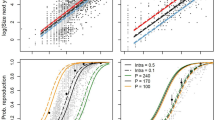Abstract
The significance of dynamic processes of individual genets/ramets for the spatial pattern of plant species and community structure is discussed. It is suggested that under a different mode of competition (symmetric vs. asymmetric), spatial distribution of individuals, initial size distribution at the establishment stage and boundary conditions as recruitment influence differently the species coexistence pattern. It is therefore important to consider the mode of competition for the study of community structure. To know the mode and degree of intra- and interspecific competition, the dynamic processes of individual genets/ramets must be studied by following the growth, mortality and recruitment of each genet/ramet of each component species in a plant community. The models and methods of plant population ecology are therefore useful also for plant community ecology.
Similar content being viewed by others
References
Hara T. (1984a): A stochastic model and the moment dynamics of the growth and size distribution in plant populations.—J. Theor. Biol. 109: 173–190.
Hara T. (1984b): Dynamics of stand structure in plant monocultures.—J. Theor. Biol. 110: 223–239.
Hara T. (1988): Dynamics of size structure in plant populations.—Trends Ecol. Evol. 3: 129–133.
Hara T. (1992): Effects of the mode of competition on stationary size distribution in plant populations.—Ann. Bot. 69: 509–513.
Hara T. (1993): Effects of variation in individual growth on plant species coexistence.—J. Veg. Sci. 4: 409–416.
Hara T. (1994): Growth and competition in clonal plants—Persistence of shoot populations and species diversity.—Folia Geobot. Phytotax. 29: 181–201.
Hara T. &Wakahara M. (1994): Variation in individual growth and the population structure of a woodland perennial herb,Paris tetraphylla.—J. Ecol. 82: 3–12.
Hara T. &Wyszomirski T. (1994): Competitive asymmetry reduces spatial effects on size-structure dynamics in plant populations.—Ann. Bot. 73: 285–297.
Hara T. &Yokozawa M. (1994): Effects of physiological and environmental variations on size-structure dynamics in plant populations.—Ann. Bot. 73: 39–51.
Hara T., Kimura M. &Kikuzawa K. (1991): Growth patterns of tree height and stem diameter in populations ofAbies veitchii, A. mariesii andBetula ermanii.—J. Ecol. 79: 1085–1098.
Hara T., Nishimura N. &Yamamoto S. (1995): Tree competition and species coexistence in a cool-temperate old-growth forest in southwestern Japan.—J. Veg. Sci. 6: 565–574.
Hutchings M.J. (1986): The structure of plant populations.—In:Crawley M.J. [ed.]: Plant ecology, Blackwell Scientific Publications, Oxford, pp. 97–136.
Keddy P.A. (1994): Applications of the Hertzsprung-Russel star chart to ecology: reflections on the 21st birthday of Geographical Ecology.—Trends Ecol. Evol. 9: 231–234.
Klimeŝ L., Jongepier J.W. &Jongepierová I. (1995): Variability in species richness and guild structure in two species-rich grasslands.—Folia Geobot. Phytotax. 30: 243–253.
Kohyama T. (1991): Simulating stationary size distribution of trees in rain forests.—Ann. Bot. 68: 173–180.
Kohyama T. (1992): Size-structured multi-species model of rain forest trees.—Funct. Ecol. 6: 206–212.
Koyama H. &Kira T. (1956): Intraspecific competition among higher plants VIII. Frequency distribution of individual plant weight as affected by the interaction between plants.—J. Inst. Polytechn. Osaka City Univ. 7: 73–94.
Kubota Y. & Hara T. (1995): Tree competition and species coexistence in a sub-boreal forest, northern Japan. —Ann. Bot. 76 (in press).
Kuroiwa S. (1960): Intraspecific competition in artificial sunflower communities.—Bot. Mag. (Tokyo) 73: 300–309.
Lepŝ J. (1995): Variance deficit is not reliable evidence for niche limitation.—Folia Geobot. Phytotax. 30: 455–459.
Obeid M., Machin D. &Harper J.L. (1967): Influence of density on plant to plant variation in fiber flax,Linum usitatissimum L.—Crop Sci. 7: 471–473.
Tilman D. (1988): Plant strategies and the dynamics and structure of plant communities.—Princeton University Press, Princeton.
Watkins A.J. &Wilson J.B. (1992): Fine-scale community structure of lawns.—J. Ecol. 80: 15–24.
Weiner J. (1990): Asymmetric competition in plant populations.—Trends Ecol. Evol. 5: 360–364.
Westoby M. (1982): Frequency distributions of plant size during competitive growth of stands: the operation of distribution-modifying functions.—Ann. Bot. 50: 733–735.
Wilson J.B. (1995): Testing for community structure: a Bayesian approach.—Folia Geobot. Phytotax. 30: 461–469.
Wilson J.B., Gitay H. &Agnew A.D.Q. (1987): Does niche limitation exist?—Funct. Ecol. 1: 391–397.
Author information
Authors and Affiliations
Rights and permissions
About this article
Cite this article
Hara, T. Dynamic process, spatial pattern and species coexistence in plants. Folia Geobot 30, 529–533 (1995). https://doi.org/10.1007/BF02803982
Issue Date:
DOI: https://doi.org/10.1007/BF02803982




